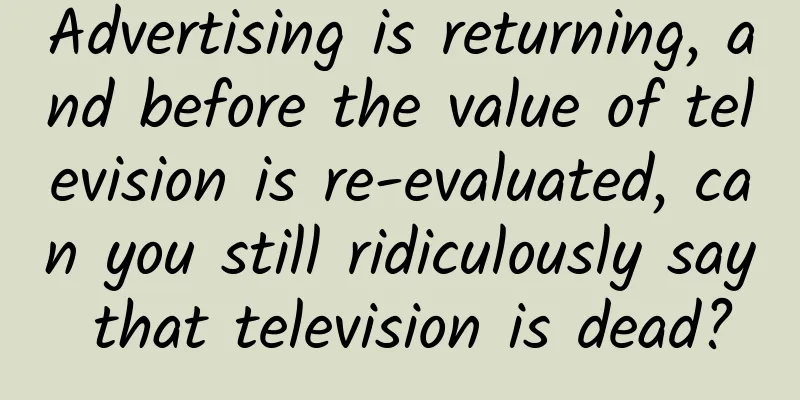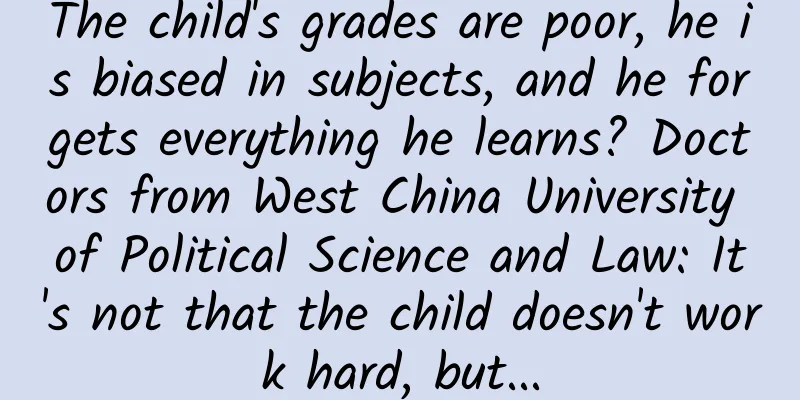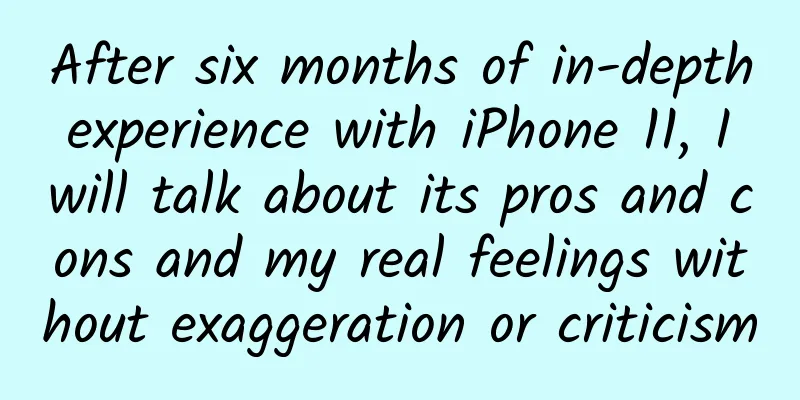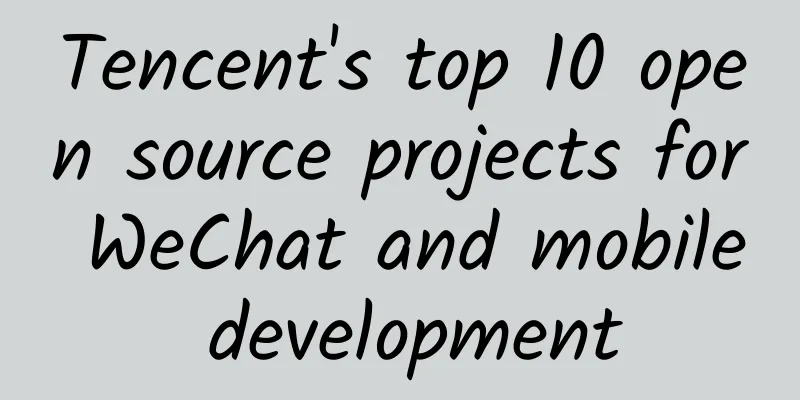Advertising is returning, and before the value of television is re-evaluated, can you still ridiculously say that television is dead?

|
The value of television is seriously underestimated TV media placement returns The value of traditional television is being underestimated, and seriously underestimated. The Internet has been around for so many years, and the traffic has been rolling up to such a large scale, but has the Internet ever produced a national star? On the other hand, television produces national stars every year, and this phenomenon still exists when traditional television is so unpopular. The 2017 advertiser survey shows that there is no significant change in the budget allocation ratio of advertisers compared with last year. Television media is still the most important part of advertisers' budget allocation, while OTT and mobile Internet media have a slight increase. In recent years, some big brands have gradually returned to large-screen TVs, and the value of TVs has begun to be re-evaluated: Last August, Procter & Gamble, the world's largest advertiser, reduced its advertising expenses on "targeted delivery" on Facebook because the results were not obvious, and increased its investment in traditional media such as television. In the recently popular reality show "Where Are We Going, Dad?" Season 5, P&G's Safeguard products have appeared repeatedly in the TV content in the form of soft implants. At the end of 2016, the century-old outdoor clothing brand Eddie Bauer launched a 30-second TV commercial during the holiday season, marking the brand's first return to TV screens since 1999. Its CEO Mike Egeck believes that television has the advantage of reaching consumers widely, which is conducive to strengthening the brand's information delivery. After trying more new media channels, some big brands have also begun to gradually return this year. For example, Yili's TV advertising expenditure decreased by 0.3% year-on-year in the first half of 2016, but increased by 37.8% year-on-year in the first half of this year. In March this year, in response to whether Adidas's abandonment of its television advertising strategy would affect the Chinese market, Adidas China responded to reporters on March 17 that it would continue to communicate with Chinese consumers through television. According to Caixin, Sun Jingbo, head of Adidas China's corporate communications department, said, "In China, Adidas will continue to communicate with consumers through diversified media channels, including television. Television remains our main and very important media channel." Internet traffic is called the cocoon effect False advertising traffic fraud breeds trust crisis Many people think that the cooperation between Internet companies and traditional media is to find traffic offline, but our experience is not like that. The traffic on the Internet has a strong characteristic called the cocoon effect, just like a silkworm, constantly spinning silk, wrapping itself in a small cocoon that is getting tighter and narrower. Your connection with the entire society is cut off. The people who know you are your users and are very familiar with you, and people who are not your users don’t even know you exist. This is a major logical flaw in Internet products. Information cocoon refers to the phenomenon that people's information field is habitually guided by their own interests, thus confining their lives to a "cocoon" like a silkworm cocoon. It is not difficult to see that new media advertising has the disadvantages of limited influence, loss of mass base, and inability to stimulate public demand. In addition, problems such as false advertising and traffic fraud have intensified the trust crisis of brand owners in advertising. A report shows that global companies will lose $16.4 billion to online advertising fraud in 2017, and nearly 20% of total digital advertising spending in 2016 was wasted. TV ads break through the circle Citizens’ consciousness is activated and awakened In the past, when we were doing placement, advertising, and marketing, there was actually an underlying assumption that we had to find new users, or to find brand new users among the unfamiliar masses. You have to know that in a country as large as China, there are actually a large number of people who have not become core users of the Internet. If we only follow the original logic of the Internet, it will be difficult for these people to become users of Internet products. But at this time, turning to television is very useful. I don’t know whether newspapers will die or not, but television will definitely not die. This is because it is a consensual, pulsed, and influential communication method. It is one-to-many, not one-to-one. This also proves a point: in terms of conveying emotional expression, causing resonance, highlighting selling points, reaching the audience to the greatest extent, and secondary dissemination, television media has incomparable advantages over new media in expressing brand appeals in advertisements and shaping and enhancing brand image. Matching between user structures Citizens’ consciousness is activated and awakened Therefore, the combination of new brands and products on the Internet and traditional media and then coming back to television, in fact, this cooperation is no longer the typical "traffic-based cooperation", but a match between different user structures. Now, when all brands place TV ads, are they trying to attract new and unfamiliar users, or are they trying to show their users something different, thereby inspiring their inner pride and identification with the brand? As a long-standing consumer habit, whether television will disappear depends on whether the audience disappears from this habit. At least in our lifetime, as long as users still have the habit of using television, television will not disappear, it will only weaken in degree. The boundaries between new media and traditional media have become blurred Many people have been asking what the difference is between new media and traditional media, and what possibilities of interaction there are. Talking about this question again in the second half of 2017, it seems a bit outdated because the boundary between new media and traditional media is no longer so clear. Two research reports, "2016 China Internet News Market Research Report (2017)" from CNNIC and "News, Media and Technology Trend Forecast 2017" from Reuters Institute, believe that television and online video are becoming difficult to distinguish. In the future, it is estimated that there will no longer be a distinction between new media and traditional media, because all means can be used to do integrated business, both traditional media and new media can do it, so the distinction will become smaller and smaller. It is not difficult to see that, on the one hand, mainstream media are actively deploying in new media and seizing the right to speak; on the other hand, with the standardization of state control over new media and the market's recognition of new media, new media are gradually becoming mainstream media. Summarize Television media remains the most important part of advertisers' budget allocation. In recent years, some big brands have gradually begun to return to large-screen TVs, and the value of television has begun to be re-evaluated. Only television can meet the communication needs that come from deep in human nature. Television can break through circles. The cooperation between Internet brands and television is no longer a "traffic-based cooperation", but a match between different user structures. As a long-standing consumption habit, whether television will disappear depends on whether the audience disappears from this habit. New media advertising has drawbacks such as limited influence, loss of mass base, inability to stimulate public demand, false advertising, and traffic fraud. Television media has incomparable advantages over new media in terms of conveying emotional expression, causing resonance, highlighting selling points, reaching the audience to the greatest extent, and secondary dissemination, in expressing brand appeals in advertisements, and shaping and enhancing brand image. As a winner of Toutiao's Qingyun Plan and Baijiahao's Bai+ Plan, the 2019 Baidu Digital Author of the Year, the Baijiahao's Most Popular Author in the Technology Field, the 2019 Sogou Technology and Culture Author, and the 2021 Baijiahao Quarterly Influential Creator, he has won many awards, including the 2013 Sohu Best Industry Media Person, the 2015 China New Media Entrepreneurship Competition Beijing Third Place, the 2015 Guangmang Experience Award, the 2015 China New Media Entrepreneurship Competition Finals Third Place, and the 2018 Baidu Dynamic Annual Powerful Celebrity. |
Recommend
How to efficiently learn and master new technologies
Recently, I have learned and practiced React, whi...
AI autonomous weapons are here, our generation’s Oppenheimer moment is here
In the conflict between Russia and Ukraine, a vid...
A brief analysis of the six product and operation concepts implied by "Dangal"
Last weekend, I took advantage of my free time to...
How to create product "growth power"?
Being able to demonstrate early growth is a key e...
Not only from north to south, but also from east to west, in a circle... "Where do birds go?"
As the northern hemisphere enters winter, a spect...
The first red warning for heavy rain this year! The "violent plum rain" in the middle and lower reaches of the Yangtze River continues to exert its force. How to prevent and avoid risks?
Just now, the Central Meteorological Observatory ...
3 major challenges in acquiring new customers!
First of all, why do we need to do customer acqui...
Does hair dye cause cancer? What is the difference between hair dyes that cost tens of dollars and hundreds of dollars?
When dyeing their hair, many people often look fo...
Tsinghua Unigroup may acquire Apple's GPU supplier, and now it will have its own CPU and GPU
On April 3, Apple announced that it would stop us...
The first step of brand promotion: 5 ways to stimulate marketing ideas
Brand promotion is not just a high-sounding conce...
Tencent QQ launches QQ public platform, you can’t miss it!
For us, there is no need to say how important QQ ...
Beware! Don’t squeeze pimples! A man developed a hemangioma because of this…
Everyone loves beauty, but acne comes from time t...
What are some common problems you may encounter in website maps?
Friends who do website SEO optimization may be fa...
How to seize the Spring Festival marketing opportunities when people stay at home to celebrate the New Year?
The Spring Festival is approaching, and Spring Fe...
Zheng Xiangzhou-New Business Model Complete Works Value 12980
Zheng Xiangzhou-New Business Model Complete Works...









